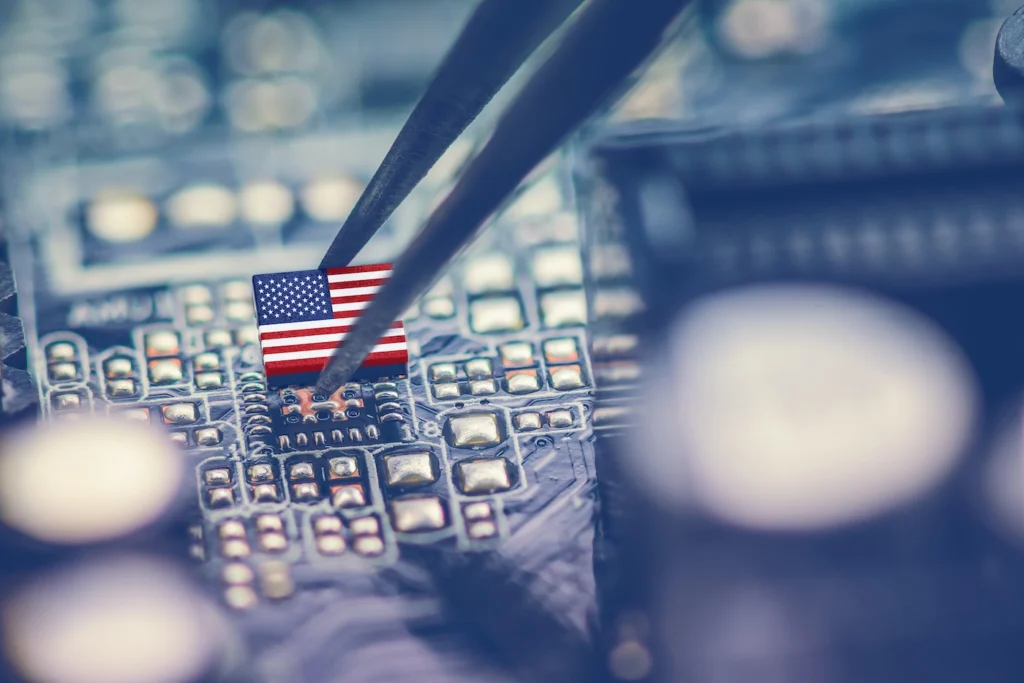In my previous article, I explained five ideas. First, that chips are the fundamental building block of the modern economy, much more so than oil. Second, that because of the enormous economies of scale in the industry, semiconductor production—especially the most advanced ones—is incredibly concentrated in Taiwan and South Korea, a region with high geostrategic instability. Third, that the United States controls the most important part of the value added in the semiconductor industry (since the physical production of semiconductors is only one step in the industry, which also requires design, software, etc.). Fourth, that for the past decade, China has been trying to capture a larger share of this global value added. And fifth, given the military repercussions of the Asian giant’s progress in semiconductor production, the United States launched an aggressive and unusual campaign of restrictions on the export of technology in this sector to China, with the announcement of new regulations on October 7, 2022, which heralded a new stage in the world economy.
Today I will explain how we have arrived at this situation and outline future prospects for the coming years. It is a complex story, which I will have to summarize and—much to my regret—in some cases simplify (a more extensive treatment appears in Chris Miller’s 2022 book, Chips War, although events have accelerated since the book’s publication).
Recent History
For many decades, US semiconductor policy was relatively lax. The idea was that the US could always “run faster” and stay two generations ahead of its competitors with semiconductors (this strategy was called “sliding scale”). Though the cheapest semiconductors were manufactured in East Asia, this benefited American companies, which could control their production costs and keep the most profitable rungs of the value-added chains (programming, marketing, etc.) in the United States. In addition, this division of labor helped to foster strategic allies surrounding China (Japan, South Korea, and Taiwan).
Start your day with Public Discourse
Sign up and get our daily essays sent straight to your inbox.This US policy had one exception: the Soviet Union. From the American perspective, limiting the Soviet Union’s access to the most advanced technology meant that Soviet military forces could not adequately compete. In reality, the only real advantages of export limitations on the Soviet Union were rhetorical. Its socialist system was so flawed at its roots that it could never support a powerful semiconductor industry. Much of East Germany’s economic ruin came precisely from trying to mass-produce semiconductors under a system as absurd as a centrally-planned economy.
These pragmatic considerations (advantages of the international division of labor, aid to East Asian economies, the inefficiency of socialism) were complemented by economic ideas that in the 1980s and 1990s, emphasized the advantages of international trade and distrusted governmental industrial policy. As Michael Boskin once, evidently, said: “Potato chips, computer chips—what’s the difference?”
Boskin had a point. May you, the reader, look around. Most of your material possessions, except for your house, are probably not made in your home country—from the electronic device you are using to read this, to the clothes you are wearing. This incredible internationalization of the economy has also meant, for instance, that for my home country, Spain, we have been able to emerge from the morass of economic autarky that resulted from decades of misguided policies. Internationalization works, and Spain is the best example: in 1960, Argentina had a per capita income 19 percent higher than ours, today Spain enjoys more than double Argentina’s per capita income.
The problem, of course, is that international trade is a very good idea when your partner does not intend to use the profits from this trade to undermine your national security. There is no perfect trading partner (as there is no perfect person) and every partner is going to overstep the mark on more than one occasion (as Spanish, Danish, or Slovakian companies often do). But everything is a question of proportionality. Driving at 26 mph in a 25-mph zone is not the same as driving at 190 mph.
Yes, Japanese or Korean companies often overdid it in the ‘80s and ‘90s, but all within a basically reasonable margin. Even China, from the beginning of its economic reform in 1979 until about 2012, behaved in a way that could be accommodated by international trade rules. Again, I stress, China was not perfect, but no other nation was.
As I pointed out in my previous article, the problem is that Xi Jinping came to power in 2012 with the idea of breaking the deck. Xi distrusts international rules (both political and economic). He thinks that the United States is in terminal decline, that Europe is a pygmy obsessed with irrelevant issues such as human rights and democracy, and that the time has come for China to retake its rightful place in international relations, merited by its history, population, and economy. Moreover, this repositioning must be done through the iron grip of the Communist Party, which is the only institution that in his opinion, can ensure China’s future. And all this, of course, involves semiconductors: the backbone of the entire modern economy.
Between 2014 and 2015, the United States began to realize that Xi is different from his predecessors. The final years of Obama’s presidency marked growing concern over China’s new aggressive style, both internally (increased repression, massive concentration camps in Xinjiang) and externally. Suddenly, the question seemed no longer to be whether Chinese companies are going to take a 5 percent market share from them in the semiconductor industry in a somewhat crooked way. Instead, it was about a geostrategic rival that wants to reshuffle the world map.
The Gun Went Off
Although the details of this shift in US foreign policy are complex, the gun for our issue, semiconductors, went off in October 2016 when Commerce Secretary Penny Pritzker warned in a speech to the Center for Strategic and International Studies in Washington, DC, that there are “new attempts by China to acquire companies and technology based on their government’s interests—not commercial objectives.” And before that, “The US government will make clear to China’s leaders at every opportunity that we will not accept a $150-billion industrial policy designed to appropriate this industry.”
The unexpected electoral victory of Donald Trump a few days after Penny Pritzkers speech reinforces this new vision. There is a fundamental and underappreciated continuity in US foreign policy from Obama’s second term through Trump to Biden.
The first battle in this US–China standoff centered on ZTE and Huawei. These two companies specialized in telecommunications equipment: a particularly tricky subject. Several European governments learned during the last few years that their ministers’ cell phones had been hacked and their private conversations spied on by unknown third parties. The problem here was not just that ZTE and Huawei violated too many intellectual property rules and skirted sanctions on Iran and North Korea, but that both companies had close relationships with the Chinese government—one being semi-public and the other with opaque shareholding.
ZTE was fined in 2017 for selling banned equipment to Iran and North Korea, and after much back and forth, the company remains sanctioned in the United States, with a recent prohibition on exporting telecommunications equipment. The case of Huawei is similar, with a ban on purchases of this company’s products by the federal government in 2018 and additional sanctions in the following years. There was the issue of controlling such an important technology as 5G, where Huawei had significant advantages. And in 2022 it was SMIC’s turn to be banned, due to its close links with the Chinese armed forces.
China’s reaction to this first battle was interesting. Of course, it complained in public and protested to international organizations (there are complex issues here of international trade law and the jurisdiction of the World Trade Organization). But on the whole, there was little retaliation. Did Xi think that this was not the time to escalate the confrontation? Or that perhaps the US would tire of these battles, as the price of phones and other telecommunications equipment went up, and the sanctions would fade over time, especially given Trump’s volatile nature? Or did he think simply that the sanctions were not very effective and therefore not worth fighting over?
Then came COVID and everything accelerated. In a production-constrained world, securing semiconductor supply was a clearer priority than ever. Significantly, one of the few companies to receive exemptions from the draconian COVID containment policy by the Chinese government was Yangtze Memory Technologies. Moreover, we all became aware of the lack of chips and the enormous risks that the concentration of production in Taiwan and South Korea carried in a world where the old rules of collective security were being pulverized by Putin’s aggression in Ukraine and China’s change of rhetoric regarding Taiwan.
And like the 1980s, faddish ideas tend to reinforce these geostrategic tensions. Although the empirical evidence that industrial policy works is rather scant (for every example where it has worked, there are five examples of failure: a pretty bad batting average), it came back into vogue a few years ago in certain circles. My interpretation is that this resurrection of interest in industrial policy is based on a clear reality—that is, the poor productivity growth in many advanced economies since 2000 and the consequent stagnation of wages. But it misses the diagnosis (again, with a few exceptions): this stagnation has more to do with demographics than with any other factor.
New US Strategy
It is the confluence of all these forces (economic, geostrategic, and ideological) that lead to Jack Sullivan, the National Security Advisor for the Biden administration, giving two key speeches, one on September 16, 2022 and another a few days later, on October 12, 2022. I invite the reader to read the two speeches in their entirety (links for the first and second here). It is better to start with the second speech, which announced the new US national security strategy, and then go to the first one, which, although delivered a few days earlier, describes in more detail the specific measures regarding semiconductors.
Here are some of the fundamental ideas of these two speeches (I am merely summarizing what Sullivan said, not agreeing or disagreeing with it):
- The United States believes it is in the early years of a decisive decade that will set the terms of its relationship with China.
- The United States judges that China’s behavior, both in domestic and foreign policy, is promoting an illiberal vision in the economic, political, security, and technological arenas in competition with the West.
- The United States finds that China is the only competitor that has both the intent to reshape the international order and the growing capacity to do so.
- The United States does not see Russia as that strategic rival. The war in Ukraine has made it clear that Russia is a paper tiger, except for its nuclear weapons.
- US superiority in the three key technologies of the twenty-first century, a) computing, b) biotechnologies, and c) energy, is a top strategic priority.
- The United States will abandon its “sliding scale” policy. The United States will now seek to maintain as large a technological edge as possible.
- To this end, the United States will invest large amounts of money in research and manufacturing of the three technologies listed in the fifth point.
- At the same time, it will establish “small yard, high fence ” to limit China’s access to new technologies.
What does “small yard, high fence” mean? That, instead of establishing very broad restrictions on the export of technologies, in this case semiconductors, the United States is going to focus on creating very strong barriers (the “high fence”) at very specific pressure points (“the small yard”; for example, as I explained in my previous article, on extreme ultraviolet light photolithography machines and the lasers they use), but which are essential in the manufacture of more advanced semiconductors. It is this “robust guardrails” strategy that is reflected in the October 7, 2022 restrictions.
Will this new US strategy work? There are several points to consider. First, the United States does not control all the most advanced technologies. In particular, we have the leading lithography company, ASML, located in the Netherlands; and a leading company in the silicon wafer industry, Tokyo Electron in Japan (the other three key companies here, Applied Materials, Lam Research and KLA are US companies and therefore fully subject to federal government restrictions).
The United States appears to have secured some government cooperation from the Netherlands and Japan, although its effectiveness remains to be seen. Technology companies have a long history of “obey but don’t comply” on these issues. ASML does not seem to be in the mood to be overly helpful, and since some of their equipment does not depend on US patents that are subject to possible restrictions, they have a certain degree of freedom. Japan, on the other hand, with China on the prowl, appears to be more willing to cooperate with the United States. And then there is Taiwan, which is in a complicated situation: it neither wants to lose its technological advantage by setting up factories in the United States (which also makes it less important for the United States to defend), nor does it want to unnecessarily provoke China.
My reading of the situation (while cautioning that I lack access to insider information on the trade secrets of these companies) is that at least in the short term, the United States will control enough pressure points to make life seriously difficult for the Chinese semiconductor industry.
How Will China React?
The second point to consider is China’s ability to react to these restrictions. I do not buy the argument made by opponents of the new export restrictions. They claim the restrictions will incentivize China to develop its own industry. But the reason the United States approves the sanctions is because China is already doing this. The incentive already existed! Perhaps it is stronger now, but the difference is marginal.
In the past, China has been very creative in solving its problems of access to forbidden technologies, as it did during the development of satellites in the 1990s (I recommend Hugo Meijer’s book about the US restrictions on technological exports to China since 1979). This past success suggests that in a few years, China may have made up much of its backlog in semiconductor manufacturing, especially in a world of high technological diffusion. For example, RSIC-V is a free hardware instruction set that has improved tremendously in recent years and may change the future of the industry for some time to come. There are no secrets in RISC-V: it’s all in the network.
As before, this argument about China’s ability to catch up is often presented as a reason not to impose restrictions. Again, I believe this argument is flawed. From the US perspective, any additional delay in China’s convergence to the technological frontier is a net gain. If China catches up to the US in 2030, rather than 2025 (to posit two arbitrary years), then thanks to restrictions, that is five years of additional geostrategic advantage. Foreign policy is about surviving tomorrow. The day after tomorrow, we shall see.
But it is not just a question of short-sightedness or short-termism. The United States believes that the reputational cost with China of these new restrictions is small (relations were already broken, so there is not much “continuation value” to maintain) and that in the long term, the future is in its favor. Both demographically and in terms of social vitality, the US is much better positioned than China (this book, and this other one, are two recent accounts of this perspective). My own more recent research on China suggests that the combination of perverse demographics and a clear drop in productivity growth predict economically bad times in the 2030s for the Asian giant.
Considering these two points together: yes, the United States will be able to inflict damage on the Chinese semiconductor industry, and while this impact is not absolute, it is enough to justify embarking on this policy. In a world where there are no magic wands for anything, but only partial patches to complex problems, this is the policy that maximizes the benefits to the United States, at least in light of what we know right now.
This article is adapted from a version originally published in February 2023 at El Confidencial, a leading Spanish digital newspaper. We are grateful to Professor Jesús Fernández-Villaverde for his permission to publish it in English here, and to Thomas Howes for his translation.














